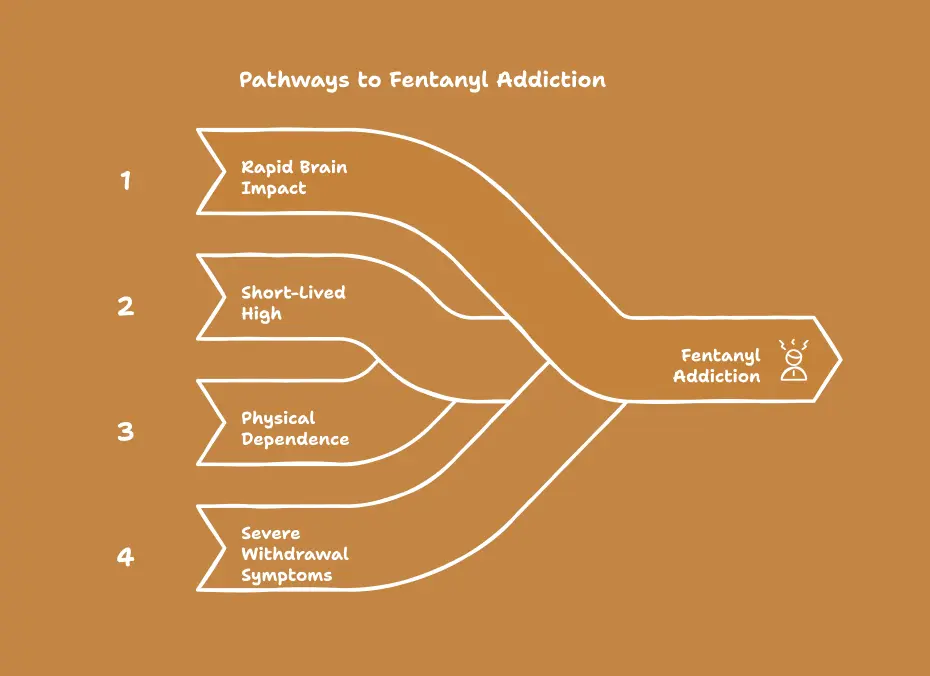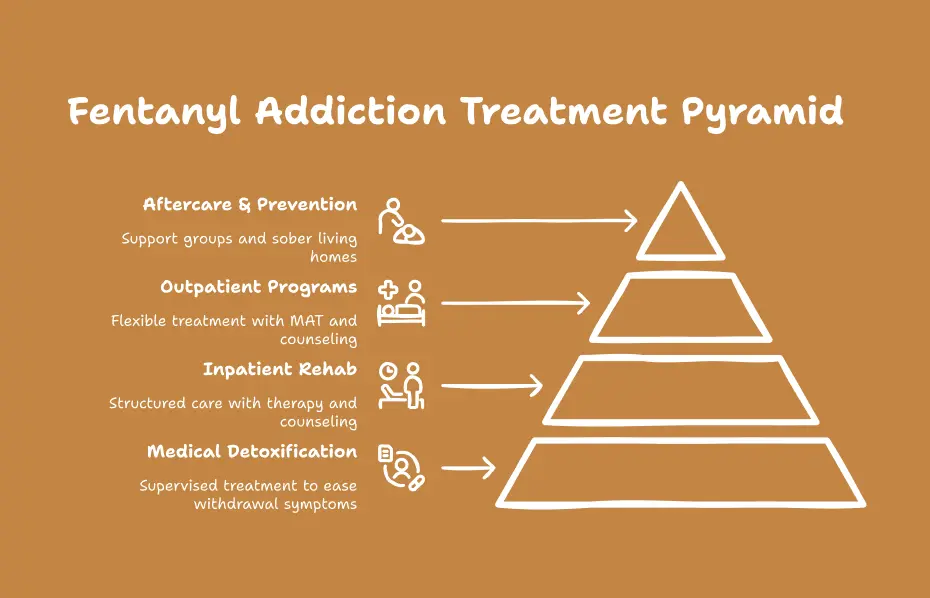As a synthetic opioid substance, Fentanyl demonstrates 50 times higher strength than heroin and 100 times more potency than morphine. Manufactured for medical pain treatment purposes, fentanyl developed into a primary origin of the opioid crisis because users find it extremely addictive and spread illegally. Personal knowledge of fentanyl addiction and its symptoms and treatment solutions provides essential information to people who encounter this lethal drug. The discussion in this article examines fentanyl’s toxic addiction levels and symptoms of addiction as well as recovery treatment, along with addressing questions about addicts hunching over. In addition to these questions, the article also addresses “What is the fentanyl addiction recovery rate?
Understanding the nuances of illicit fentanyl use often involves recognizing the various fentanyl street names that circulate, which can provide insight into the drug’s prevalence and distribution. For individuals and families struggling with addiction, finding the right support is crucial, and exploring dedicated rehab facilities in Florida can be a vital first step towards recovery.
What is Fentanyl?
Medical experts created Fentanyl as a manufactured opioid drug for intensive pain relief strategies used in medical treatment. Doctors provide this medication to patients undergoing surgical recovery or patients who experience ongoing pain issues. Medical professionals consider this powerful drug substantially stronger than morphine after converting it to its equivalent measurements. Three options exist for pharmaceutical fentanyl delivery: patches, lozenges, and injectable solutions. The sole danger originates from illicitly manufactured fentanyl (IMF). The selling of illicit manufactured fentanyl involves its combination with heroin and cocaine without any indication of the drug’s potency.
The drug’s powerful onset of effects continues to attract users at great risk. People using substances are unaware that the substance they are taking could trigger a life-threatening overdose in such a short period. Its powerful composition and budget-friendly nature lead to more Americans developing addictions and numerous deaths from overdoses throughout the United States. Knowing about the true nature of fentanyl stands as the basis to address its dual influence on individuals and the community. For a deeper dive into the chemical properties and medical applications of fentanyl, the National Institute on Drug Abuse (NIDA) provides comprehensive insights on its use and effects.
The Risks Associated With Fentanyl Addiction
The synthetic opioid called Fentanyl presents dangerous health threats to everyone using it. A minimal quantity of the drug results in a fatal overdose. Too many individuals underestimate how strong fentanyl is because they think they can manage its use.
The incorrect understanding of fentanyl leads people into dangerous conditions because they might unknowingly consume hazardous quantities. The drug affects human respiratory functions severely enough to prove fatal despite its main risks through addiction.
A person experiencing a fentanyl overdose will immediately face dangerous respiratory trouble, which can end in death unless emergency medical aid is obtained quickly. The illegal addiction of other drugs to fentanyl happens undetected by users, thus creating a serious risk of sudden fatal reactions. Fentanyl dangers create casualties that extend throughout families while causing communities to experience both emotional and physical consequences from fentanyl-induced deaths.

Why is Fentanyl So Addictive?
The intensely strong properties of Fentanyl position it as one of the most addictive drugs. Here’s why:
1. Rapid Brain Impact
Fentanyl functions much more swiftly than conventional opioids when it attaches to brain opioid receptors, which results in powerful feelings of euphoria.
2. Short-Lived High
Because the drug acts rapidly in the body, users experience a quick effect duration, thus needing to use it more often, leading to dependence development.
3. Physical Dependence
The human body develops a fast tolerance to fentanyl, which forces individuals to use greater amounts of the drug to experience similar effects.
4. Severe Withdrawal Symptoms
The pain experienced during fentanyl withdrawal greatly increases the chances of a person returning to drug use.
Fentanyl addiction becomes established after a few uses, which can occur either intentionally or by chance when individuals consume it with heroin or cocaine.
Signs & Symptoms of Fentanyl Addiction
The detection of fentanyl addiction proves difficult because its initial warning indicators mimic ordinary conduct. Some specific symptoms suggest the existence of underlying health concerns. Symptoms include;
Physical Symptoms
- Drowsiness or “nodding off”
- Slowed breathing (respiratory depression)
- Constricted (pinpoint) pupils
- Nausea and vomiting
- Itching or flushed skin
- Weight loss due to suppressed appetite
Behavioral Symptoms
- Secretive behavior (hiding drug use)
- Neglecting responsibilities (work, school, family)
- Financial problems (spending excessively on drugs)
- Doctor shopping (seeking multiple prescriptions)
- Using despite health risks
To understand the alarming scale of the fentanyl crisis and its impact on overdose deaths across the United States, reviewing recent statistics can provide crucial context. Data shows a significant increase in fentanyl-related fatalities in recent years, highlighting the extreme dangers associated with this potent opioid. For comprehensive information on fentanyl misuse and overdose statistics, refer to the American Addiction Centers’ Fentanyl Statistics.
Why Do Fentanyl Addicts Hunch Over?
Many people wonder why fentanyl addicts tend to keep their bodies in a bent position. This happens because:
- Central Nervous System Depression: Fentanyl consumption reduces brain function, which produces extreme sleepiness together with poor body posture.
- Muscle Relaxation: Opioids create muscle relaxation that prevents a person from maintaining an upright position.
- Overdose Indicator: Medical professionals should use naloxone immediately when they identify an unresponsive person who is slumped over.
The Role of Support Systems in Recovery
Any person who deals with the complexities of fentanyl addiction needs strong support structures to succeed. They give emotional support and practical aid throughout the recovery journey.
A person’s recovery benefactors include family, friends, and support group associates. When you struggle with addiction, it becomes acutely lonely to traverse this path independently, but having people who grasp your addiction enables you to become resilient.
Recovery activities with fellow addicts help people reduce feelings of loneliness. The process of sharing life experiences produces spaces that welcome openness without fear of adverse criticism.
The combination of professional counseling services with therapist support serves to augment peer and familial bonds in the recovery journey. Professional help provides clients with coping techniques for substance use, along with necessary therapy to treat existing problems stemming from drug use. The development of a dependable network helps increase both accountability functions.

Fentanyl Addiction Treatment: What Works?
Professional help becomes necessary to treat fentanyl addiction since withdrawal symptoms are severe, and patients face a high chance of returning to drug use. Effective fentanyl addiction treatment includes:
1. Medical Detoxification
- Relief from withdrawal symptoms becomes possible through supervised treatment.
- Medications like buprenorphine (Suboxone) or methadone to ease cravings.
2. Inpatient Fentanyl Rehab
- Fentanyl treatment centers offer round-the-clock, structured care to patients.
- Therapy includes CBT along with group counseling to treat the root causes of addiction.
3. Outpatient Programs
- Flexible treatment for those with mild addiction or post-rehab support.
- The program provides medication-assisted treatment (MAT) along with counseling programs.
4. Aftercare & Relapse Prevention
- Support groups (NA, SMART Recovery).
- Sober living homes for transitional support.
For those seeking comprehensive care, understanding the full spectrum of fentanyl treatment options is crucial, as various approaches can be tailored to individual needs. You can explore a wide range of programs and find a suitable center by visiting our detailed page on fentanyl addiction treatment.
Fentanyl Addiction Recovery Rate: Is Recovery Possible?
Several variables determine the recovery success rate from fentanyl addiction. Including;
- Duration & severity of addiction
- Quality of treatment (evidence-based programs have higher success rates)
- Support system (family, therapy, community)
People undergoing proper opioid recovery treatment can achieve lasting recovery with continuing support systems, though their recovery risks failure at a rate of between 40-60%.
How to Help a Fentanyl Addict?
If someone shows signs of fentanyl addiction, take these steps:
- Educate Yourself: Addiction functions as a medical disease and not as a decision made by humans.
- Encourage Treatment: Recommend patients to follow the rehab treatment at fentanyl addiction treatment centers with compassion combined with firmness.
- Avoid Enabling: The correct response for someone struggling with addiction is to avoid monetary support while refusing to hide their addictive conduct.
- Carry Naloxone: Narcan, as naloxone functions to rescue lives when individuals experience an overdose.
Conclusion
The complex substance abuse pattern of Fentanyl impacts both individuals and the members within their families. This strong opioid controls its victims in ways that create destructive health effects, together with profound emotional distress. Early intervention requires people to understand the warning signals that indicate someone has a fentanyl addiction. Early treatment interventions become possible when people learn to identify fentanyl addiction symptoms through withdrawal and behavioral modifications. People who create connections with supportive groups will achieve better outcomes in their recovery process. Friends, family members, and professional experts form essential elements for helping people recover.
People who search for treatment at specialized fentanyl rehab facilities will find individualized methods to break free from dependency. Every person needs their customized treatment approach since the path to recovery differs among individuals. The process of adopting new changes demands bravery and resources, and a supportive network enables one to achieve this transition successfully. The path to better self-care develops protective qualities against potential relapse events. Recovery moves progressively toward renewal and hope because every change in the right direction leads to the restoration of lives impacted by fentanyl addiction.


